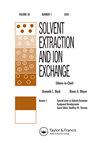Reliable Identification of Relevant Factors for the Reactive Extraction of Succinic Acid from Electrolyte Containing Solutions
IF 2.1
4区 化学
Q3 CHEMISTRY, MULTIDISCIPLINARY
引用次数: 0
Abstract
ABSTRACT Reactive extraction of succinic acid by tertiary amines is an effective separation technique. Its potential application for the initial recovery of bio-based succinic acid from fermentation broth. However, the co-extraction of inorganic anions significantly impairs the extraction performance. In this study, we use a statistically backed design of experiments method (DoE) to screen and identify the factors with a significant effect and relevant impact on extraction yield and selectivity. Eight operational factors (Extractant, solvent, succinic acid concentration, amine concentration, initial pH, the type of anion, electrolyte concentration, and temperature) were screened by applying an orthogonal design plan for the experiments. The choice of the extractant and diluent as well as the type of anion had the most significant effect on the extraction yield. In contrast, the selectivity was mainly affected by the concentration ratios of succinic acid and electrolyte. The screening plan reduced the number of experiments from 1728 possible combinations to 72 experiments required to identify the factors while maintaining the significance of the identified effects. We suggest competing mass-action relationships between the pH-dependent protonation of amines and the complexation of succinic acid to explain the observed trends. Graphical abstract从含电解质溶液中反应萃取琥珀酸相关因素的可靠鉴定
叔胺反应萃取琥珀酸是一种有效的分离技术。它在从发酵液中初步回收生物基琥珀酸方面的潜在应用。然而,无机阴离子的共萃取显著削弱了萃取性能。在本研究中,我们使用统计支持的实验设计方法(DoE)来筛选和确定对提取产率和选择性有显著影响和相关影响的因素。采用正交设计方案筛选了8个操作因素(萃取剂、溶剂、琥珀酸浓度、胺浓度、初始pH、阴离子类型、电解质浓度和温度)进行实验。萃取剂和稀释剂的选择以及阴离子的类型对萃取收率的影响最为显著。相反,选择性主要受琥珀酸和电解质的浓度比的影响。筛选计划将实验数量从1728个可能的组合减少到72个实验,以确定因素,同时保持已确定影响的显著性。我们提出了胺的pH依赖性质子化和琥珀酸的络合之间的竞争性质量作用关系,以解释观察到的趋势。图形摘要
本文章由计算机程序翻译,如有差异,请以英文原文为准。
求助全文
约1分钟内获得全文
求助全文
来源期刊
CiteScore
4.40
自引率
5.00%
发文量
15
审稿时长
8.4 months
期刊介绍:
Solvent Extraction and Ion Exchange is an international journal that publishes original research papers, reviews, and notes that address all aspects of solvent extraction, ion exchange, and closely related methods involving, for example, liquid membranes, extraction chromatography, supercritical fluids, ionic liquids, microfluidics, and adsorption. We welcome submissions that look at: The underlying principles in solvent extraction and ion exchange; Solvent extraction and ion exchange process development; New materials or reagents, their syntheses and properties; Computational methods of molecular design and simulation; Advances in equipment, fluid dynamics, and engineering; Interfacial phenomena, kinetics, and coalescence; Spectroscopic and diffraction analysis of structure and dynamics; Host-guest chemistry, ion receptors, and molecular recognition.

 求助内容:
求助内容: 应助结果提醒方式:
应助结果提醒方式:


